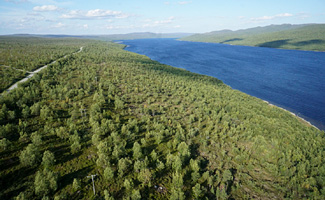
Nordic tour 2019
J.S. and S.W. Aber
| |
Introduction
We have visited and lived in southern Scandinavia, south of the Arctic Circle, many times, and we have conducted KAP extensively in Denmark and Estonia. However, our efforts farther north were limited to one brief trip to Tromsø, the main city in northern Norway, more than two decades ago in the now-distant era of film cameras.
Norway is an intensely beautiful country, as are its neighbors. Thus, the attraction for landscape photography from kites. For this trip, we planned to spend considerable time in the far north in late August and early September 2019. In particular, we wanted to visit Nordkapp (North Cape), Norway, the farthest north point that can be reached by driving in Europe at 71° 10' 21" N latitude.
The trip began with picking up a new car at the Volvo factory delivery center in Gøteborg on the southwestern coast of Sweden. From there we headed north and east. We made a preliminary stop and conducted an initial KAP session on the Baltic coast of eastern Sweden, then continued northward across the Arctic Circle into Norway and Finland.

| Taking delivery of a new Volvo (left) in Gøteborg, and crossing the Arctic Circle (right) on the border between Sweden and Finland. The flags represent the eight countries on the Arctic Circle (~66.55° N latitude).
| 
|
Weather, as always, is a critical ingredient for successful kite flying and aerial photography. Our normal sources for weather information proved somewhat unreliable, but we got excellent regional and local hour-by-hour and day-by-day forecasts from the Norwegian Meteorological Institute.
Equipment
Overseas travel for KAP is complicated by several factors beginning with airline baggage limits and restrictions for certain items such as lithium batteries. Beforehand, we reduced equipment to the minimum necessary for successful KAP. Kites, reel, RC radio, tools, and accessories were packed in a single cargo box for checked luggage. Two complete KAP rigs went into a camera case for carry-on luggage.

| Left: cargo box is checked luggage at maximum weight and dimensions to avoid an oversize fee. The reel was disassembled to pack in the cargo box. Orange camera case is carry-on luggage. Right: reel is anchored to the car's towing ring for kite flying.
|  |
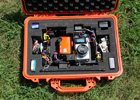
| Two complete KAP rigs. The Sony autoKAP rig (right) was our primary setup for this tour. The Nikon (left) is a radio-controlled rig that we took for backup purposes.
|
Next is electricity—supply, plugs, and sockets. Standard electricity throughout Nordic countries is 230 V and 50 Hz (see voltage by country). Most small electronic devices (cameras, laptops, smart phones) accept a range of voltages and cycles for their rechargers. However, the recharger for our RC radio and KAP-rig batteries does not, so we carry a small transformer to convert European to American voltage. Plug and socket types vary greatly around the world. Types A and B are standard in US and Canada; types C and F are used in Sweden and Norway.

| Typical European plug and sockets at top and bottom (types C & F). Black power strip accepts either American or European plugs (types A, B & C). Below it is an American plug (type B) with European adapter (type C). For further explanation, see plugs and sockets.
|
Return to top.

KAP in Sweden
Our first KAP site was on the east coast of Sweden in the village of Söråker near the city of Timrå. We stayed at a summer cottage with a small open meadow leading down to a narrow beach along the coast of the Baltic Sea. This was a perfect location to unpack, test equipment, and fix some minor electrical issues. South wind at 10-15 mph was nearly ideal and temperature was mild, but patchy cloud cover affected lighting conditions on the ground. This session was our first KAP ever in Sweden.
Söråker near Timrå, Sweden
(62.488° N, 17.513° E)

| Overview of coast (left) where we stayed. Our cottage on far left and kite flyers are upper left. Closer view (right) of our cottage at bottom center of scene.
|  |

| Close-up shot of our cottage (left). The bathhouse is a separate building on right side of deck. New house under construction (right) with more traditional houses in the background.
|  |

| Overview (left) looking along the coast toward the northwest. Closer shot (right) showing details of houses, roads, and other structures.
|  |

| Overview toward southeast (left). Cloud shadows and sun glint highlight waves on sea surface. Overview of forest to east (right) with mixed conifer and deciduous trees.
|  |
Return to top.

Magerøya, Norway
Nordkapp (North Cape) on the island of Magerøya is the farthest north point that can be reached by driving on a highway in a conventional car at 71° 10' 21" N latitude. A 7-km-long undersea tunnel opened in 1999 connects the island to the mainland. The name Magerøya is derived from Sami words "mákkar ávjo," which mean steep, barren coast (Schmutterer 2016). The interior of the island is a plateau >300 m (~1000 ft) above sea level, margins are steep cliffs, and deep fjords cut far into the sides. Tundra vegetation covers the crystalline igneous and metamorphic bedrock, and reindeer range everywhere during the summer grazing season.
The climate of Magerøya is exceptionally warm for so far north. Coastal temperatures average 20 °C higher than anywhere else in the world at this latitude (Schmutterer 2016). Flowing from the Caribbean, the Gulf Stream crosses the Atlantic, warms Iceland and Ireland, and then continues along the Norwegian coast all the way to Murmansk, Russia. The mixing of warm water with the cold Barents Sea leads to rich fishing, which is a major part of the local economy.
We spent a week on Magerøya with the intention of conducting kite aerial photography. As expected, the weather was typically terrible—fog, clouds, rain, and cold most days in late August. In fact, the summer of 2019 was unusually cold, cloudy and rainy.
We had only half a day with mostly sunny sky and moderate wind suitable for KAP. Temperature was in the upper 40s °F. We dressed in multiple layers to protect against wind chill. For example, at 46 °F (~8 °C) and wind speed of 20 mph (17 knots), wind chill is 38 °F (3 °C).
During our early days on the island, we drove the few roads and identified several potential KAP sites. So when a good weather window came, we were able to move quickly and conduct KAP at three sites, all in upland interior portions of the island. Wind speed varied from about 10 to 25 mph depending on local topographic conditions. We used our large rokkaku for light wind and a smaller delta for stronger wind in order to lift the Sony autoKAP rig.
Western Magerøya
(71.040° N, 25.630° E)

| View toward Vannfjorden to the southwest (left), and looking to the northwest (right). Highway Fv156 appears in both scenes.
|  |

| View toward the northeast (left). Nordkapp is the plateau in the far right background. Closer look (right) at outcropping bedrock strata that form bands in the tundra landscape.
|  |

| Small gravel pit in which we conducted KAP (left); kite flyers at upper left. Close-up shot of the gravel-sorting machine. Material from this pit was used presumably to build the adjacent highway Fv156.
| 
|
Eastern Magerøya
(71.056° N, 25.763° E)

| Looking toward the northeast (left). Highway E69 leads to Nordkapp, the plateau on the horizon. Terraces are prominent on slopes (right); kite flyers at upper left. These terraces are constructed of peat-rich soil and rock debris.
|  |

| The landscape has a distinctly patterned appearance. Lumpy (left) and deeply furrowed in places (right). These patterns reflect the accumulation of peaty soil and deep ground freezing (periglacial) conditions.
|  |

Panorama constructed of two overlapping images.
Looking north over tundra toward Tufjorden.
Trail to Knivskjellodden
(71.122° N, 25.707° E)

| Looking toward Tufjorden to the west (left) and northwest (right). The bleakly beautiful character of the upland tundra is evident.
|  |

| Knivskjellodden, the northernmost point on Magerøya, is reached by a long hiking trail. Left: trail visible on right side of image. Note the white spot in upper right corner; it's a mass of quartz (see below). Right: view of parking area and beginning of the trail. Kite flyers at lower right corner of parking lot.
|  |

| The authors (left) conducting KAP at Knivskjellodden trail parking area. SWA at the large mass of quartz (right) that we dubbed "dronningenstolen" (the queen's throne).
| 
|
Return to top.
Varanger, Norway
The Varanger Peninsula fronts on the Barents Sea to the north and is separated from the mainland by Tanafjorden on the west and Varganerfjorden on the south. The peninsula is a plateau about 1000 feet (~300 m) above sealevel. Deep fjords with steep cliffs cut into the plateau from the sea. Most of Norway is composed of crystalline igneous and metamorphic bedrock; however, the Varanger Peninsula is made up entirely of highly deformed sedimentary and metasedimentary rocks of late Proterozoic age. Most prominent are light gray to pale pink quartzites that form the highest mountains.
On two days with good weather, we drove on Vegen til Ishavet, the highway to the Barents Sea (890). We crossed the peninsula and found sites of opportunity to conduct kite aerial photography. Two were located in the central plateau region, and two were on the north coast in fjord settings.
Kongsfjordfjellet
(70.480° N, 28.885° E)
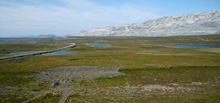
| Two views of the upland tundra plateau with a bare quartzite mountain in the distance. On the left, a small gravel pit is visible in the foreground and highway 890 appears to far left.
| 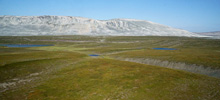 |
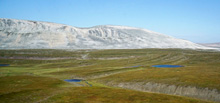
| Closer view of the quartzite mountain (left) displays folded strata and distinctive gray-pink colors. Close-up shot of a reindeer fence (right). The poles show marked relief displacement—they lean away from the image center, but their shadows remain consistent on the ground.
| 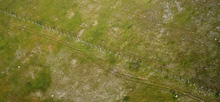
|
Kongsfjord River
(70.578° N, 29.083° E)

| This river begins in the central plateau area of tundra vegetation and flows northward to Kongsfjord. Two views looking downstream—overview (left) and close-up shot of island (right) beside highway 890.
|  |

| Two views looking upstream—overview (left) and close-up shot of cascades (right) over resistant rock layers. This river is well-known for salmon fishing, although we visited after fishing season had ended.
| 
|
Near Kongsfjord
(70.727° N, 29.269° E)
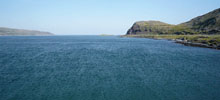
| Two views looking seaward and showing steep side cliffs. Wind blowing offshore carried the kite and camera rig far out over the water. Vegen til Ishavet (highway 890) appears on the right side.
| 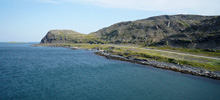 |
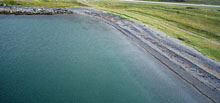
| Ridges of beach gravel mark the landward end of the fjord. Note a series of older and higher grass-covered ridges toward the right. Kite flyers on far right side.
| 
|
Løkvika, near Sandfjord
(70.789° N, 29.307° E)

| Left: overview of small inlet with sandy beach between rocky outcrops. Right: closer view displays a series of foundation ruins (*) that represent former structures, presumably fishing cabins, along the shore (see below).
|  |

| Left: small sandy beach bounded by bedrock layers standing in vertical position. Highway 890 in the background. Right: close-up view of seaweed-covered sawtooth rocks and slope covered with cobble gravel at low tide.
|  |

| Two views of a small fisherman's cabin. This cabin was originally used to store salmon; it was moved up from the shore and converted for family living during World War II, when it supported Norwegian partisans. It is reconstructed and currently undergoing a renovation, as shown by the new lumber.
| 
|
Return to top.

KAP in Finland
While visiting the Varanger vicinity, we had one day of sunny, windy weather to dip into the northernmost corner of Finland. The border between Norway and Finland follows the Tana River at Nuorgam, then cuts across Polmakvatn (lake). Most of the lake lies in Finland, and the northern end is in Norway. This lake name has more than two dozen alternate spellings in Norwegian, Finnish, and Sami languages. The spelling used here is the preferred one in Norwegian. This was our first KAP ever in Finland.
Nuorgam, Finland
(70.074° N, 27.874° E)

View to northwest

View northward

View to northeast
| | |

| Closer view of Nuorgam (left) in the foreground with farms and hay fields beyond the Tana River in Norway. The white dots are hay bales bagged in plastic, as shown in the ground view (right). Hay is essential for dairy cows during the winter.
| 
|
Polmakvatn, Finland
(69.962° N, 27.991° E)

| Views toward the north (left) and southeast (right) showing the long, narrow character of the lake with steep, forested slopes on either side. Lake surface elevation is approximately 15 m (~50 ft); width is roughly 1 km, and length is about 7½ km.
|  |

| Left: kite flyers in a small parking area on the west side of the lake. Right: view of birch forest and access road on the west side of the lake. Polmakvatn is quite similiar in size and glacial origin to Honeoye, one of the smaller Finger Lakes in western New York, which have been described as inland fjords.
| 
|
Return to top.

Nordic KAP lessons
Successful KAP depends on two key ingredients, namely sun and wind. At this high latitude, summer days are long, but the sun never rises high above the horizon, even at noon. The low sun creates strong highlights and shadows on the landscape, which have major impacts on resulting photographs, particularly for oblique views looking toward the sun.

| Owing to the low sun angle at this high latitude, we often had lens reflections that created colorful streaks in views looking toward the sun. High-oblique shot at mid-day on eastern Magerøya (~71.1° N). |
Late summer weather conditions are highly variable in the far north of Norway and Finland. Most days were generally cold, cloudy, rainy, and not suitable for kite aerial photography. This is why we scheduled a full three weeks for travel through the region. We had only a few days of sunny skies with favorable wind for KAP, and we took full advantage of those weather windows. Wind is strongly controlled by local topography.
- Upland, plateau sites with tundra vegetation typically have reliable wind with consistent direction and few gusts or turbulence.
- Fjords and deep inland valleys with steep cliffs have weaker wind with much turbulence and large variations in direction.
Most of our sites in Norway were upland sites in tundra environments for which wind was nearly ideal for KAP. We attempted three sites in fjords (Norway) and one inland valley (Finland). In the latter case, our kite took a deep dive, but we were able to arrest the dive and return the kite to high flight for eventual recovery.

| Small delta kite turning into a steep dive. We let out the line quickly, the kite stablized, and then it returned to normal flight. We were lucky not to crash the camera rig into the forest here. Polmakvatn, Finland.
|
At fjords, however, all flights ended in crashes when erratic wind either failed or put the kite into a death dive. Nonetheless, we recovered all equipment without serious damage and got some good pictures in the process. Nothing worth doing is without risk.

| Typical wind map for northern Norway showing consistent fresh breeze (frisk bris) from the S-SE over uplands and offshore. But in fjords wind is only weak (svak) or near calm (flau). Also notice radical changes in wind direction in some fjord areas. Wind speed given in meters per second; adapted from Norwegian weather forecasts.
|
In addition, we spent some time studying the regulations for public access and use of restricted areas. One site high on our list of places for KAP was the Tanamunningen Nature Reserve, an estuary salt-marsh complex at the mouth of the Tana River. Most information signs are given in Norwegian with English, German and Finnish summaries. Posted regulations in English, however, are just an abbreviation of the full regulations given in Norwegian.

| Ground view of the Tanamunningen nature reserve in the foreground with coastal mountain cliffs in the background. The salt marsh hosts many species of seasonal and migrating birds as well as an endemic variety of harbor seal (Phoca vitulina). |
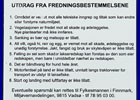
| Complete set of posted regulations. Our Norwegian is limited, but it was sufficient for us to realize that further investigation was necessary. Item 8 indicates that takeoff and landing of "luftfartøy" are not allowed. Luftfartøy is an general term for all types of flying devices, including tethered kites. Needless to say, we did not tempt fate and possible arrest by a local game warden or police.
|
 Related sites
Related sites
Reference
- Schmutterer, E. 2016. Here at the World's end – An informative tour around the North Cape, 2nd ed. Evart Forlag, Bjørkmanns, Alta, Norway, 44 p.
Text and images © J.S. and S.W. Aber
 Return to KAP gallery.
Return to KAP gallery.
Last update: October 2019.










![]() Return to KAP gallery.
Return to KAP gallery.